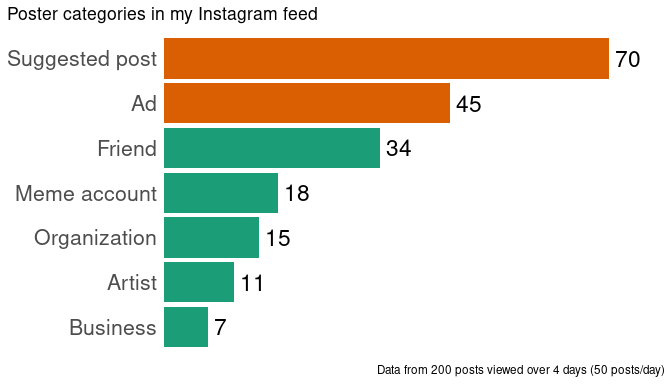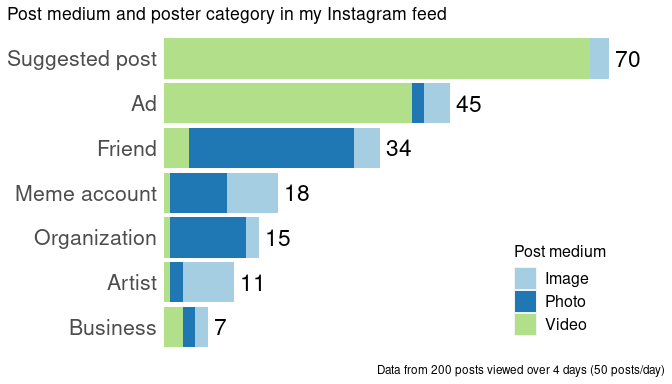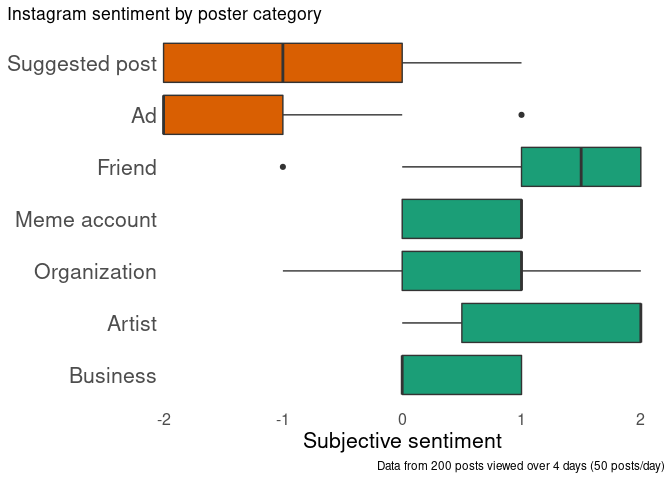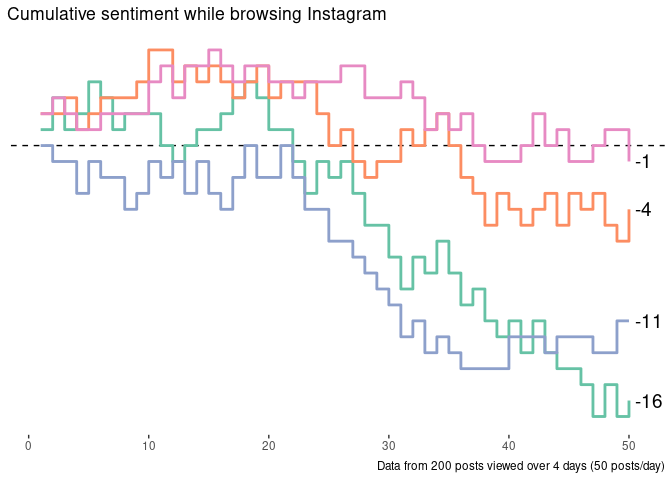I’ve been critical of social media platforms (in spite of my continued use of them), but I’ve traditionally defended Instagram. I knew that it had major problems (most galling, internal research showed that use of the platform was hurting teenage girls’ body image, and Meta suppressed the findings), but browsing IG has nevertheless been a pleasant experience for me. Photos of my friends’ pets, children, and vacations are nice things, and being exposed to them made me happy.
Recently, Instagram instituted changes to the app’s main feed, which were announced by Adam Mosseri, the head of Instagram, on Twitter. I feel like Instagram stopped being as fun for me shortly after these changes were rolled out, so I collected a bit of data.
Method
Over the course of four days (July 9–12, 2022), I only opened the app once per day, on my phone. I looked at the first 50 posts on my feed, and logged a couple features, described below, about each one. I also gave each post a subjective “sentiment score” using a five-point scale from -2 (for posts I actively disliked) to 2 (for posts I quite liked), with a score of 0 being neutral.
Results
What does Instagram show me? Let’s first look at “poster category” counts, which shows who the posts come from.

Most of the 410 accounts I follow are my friends’. I also follow a few artists (a combination of musicians, visual artists, and authors), organizations (primarily political and community orgs), businesses (all of which are run by friends—a couple bakers, a couple shop owners), and a small handful of meme accounts (e.g., “dnddads”). Subjectively, meme accounts are over-represented on my feed; I follow hundreds of actual people and only around five meme accounts, but the latter account for over half as many posts as the former.
The biggest issue here is that the majority of posts come from accounts I don’t follow. I understand that Instagram is an ad-supported business, but I see more ads than posts from friends. Worse still, I see almost twice as many “suggested posts” as I do posts from friends.
What types of content are represented by these posts?

Mosseri announced that Meta wanted to make video a bigger part of the Instagram experience, and they seem to have delivered. Of the 200 posts I logged, the majority were video. Photographs, which the app was originally designed for, account for a little over a quarter of the posts, with other types of image (drawings, illustrations, etc.) accounting for the rest.
What’s the relationship between poster category and post medium?

There’s a tight correspondence between what medium is employed for a post and who’s posting it. Videos are being pushed by accounts I don’t follow, while my friends continue to prioritize photographs.
Since post medium and poster category are so tightly linked, I’ll focus on looking at the sentiment by poster category—it would be difficult to tease apart how I feel about photos vs. videos and how I feel about posts from accounts I do vs. do not follow.

These box-and-whisker plots show the distribution of sentiment scores for each post category. The heavy vertical line indicates the median score, and the boxes extend from the first through third quartiles (the “interquartile range”, or IQR). The “whiskers” cover the full range of scores, unless any observation is identified as a potential “outlier”. Outliers are defined as observations with values more than 150% of the value of the IQR above or below the third or first quartile, respectively. For example, I was bothered by a photo of a dead bird which was posted by a friend, and gave it a score of -1. The first and third quartiles of sentiment scores for posts from friends are 1 and 2, providing an IQR of 1. Since -1 is less than 1 (the first quartile) - 1.5 (150% of 1, the IQR), that score is an outlier.
I’m not surprised that I like posts from the accounts I follow more than those from accounts I don’t. It’s disappointing that suggested posts aren’t much nicer to see than ads; these are supposed to make the platform more “immersive” and “engaging” and fail to achieve that.
In an attempt to quantify the “experience” of browsing Instagram, I looked at the cumulative sentiment scores across each of the four days. There’s no doubt that the actual dynamics of my affect, to the extent that it can even be quantified, is more complicated than +2 + -2 = 0. However, this is a good first approximation of what it feels like to scroll through a feed.

Each of the four days has a negative cumulative sentiment score, which indicates that I see more posts that I dislike than posts that I like. There’s also a suggestion of a pattern, in which my sentiment stays relatively flat and positive over the first 20–30 posts, and then drops.
I wonder if this is the result of an intentional design decision by Instagram. If they have an internal model of what posts I might like, they could certainly time them in such a way to encourage longer stretches of engagement, and they have the data to figure out what the optimal timing would look like. On the other hand, this is a purely subjective score that I didn’t attempt to carefully calibrate, so it’s worth considering that I might just get tired of my feed after a couple dozen posts.
Conclusions
I don’t know if it’s worth an attempt to use my experience to formulate suggestions to Instagram (or their would-be competitors). I’m approaching middle age, and I don’t spend much money on the internet; Instagram can get stronger engagement and much better ad conversion rates from people who aren’t like me. Perhaps I’m an unprofitable user and this is their attempt to nudge me off the platform?
However, this has been a useful exercise for me, because it suggests a few things I could change right now to improve my experience:
- Stop following meme accounts and organizations (these posts provide a neutral-to-good experience, but they potentially crowd out posts from friends and artists that I would enjoy more)
- Stop scrolling my feed after the first 20 or so posts (cumulative sentiment appears to begin dropping after this point)
Most importantly, it calls into question whether I should even continue using the platform at all. The maximum cumulative sentiment that I experienced was only six (which corresponds to seeing just three things that I really like), and that was only achieved on two of the four days that I measured this. As much as I enjoy seeing photos from my friends (and the data show that I really do enjoy this), it’s hard to conclude that the experience of using Instagram is joyful.